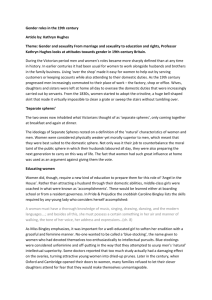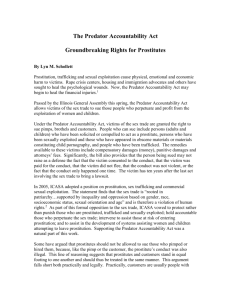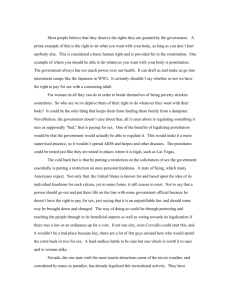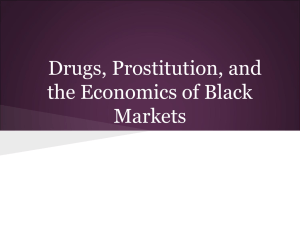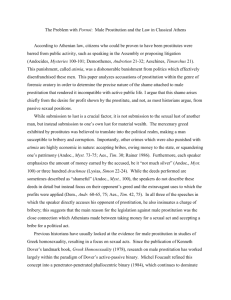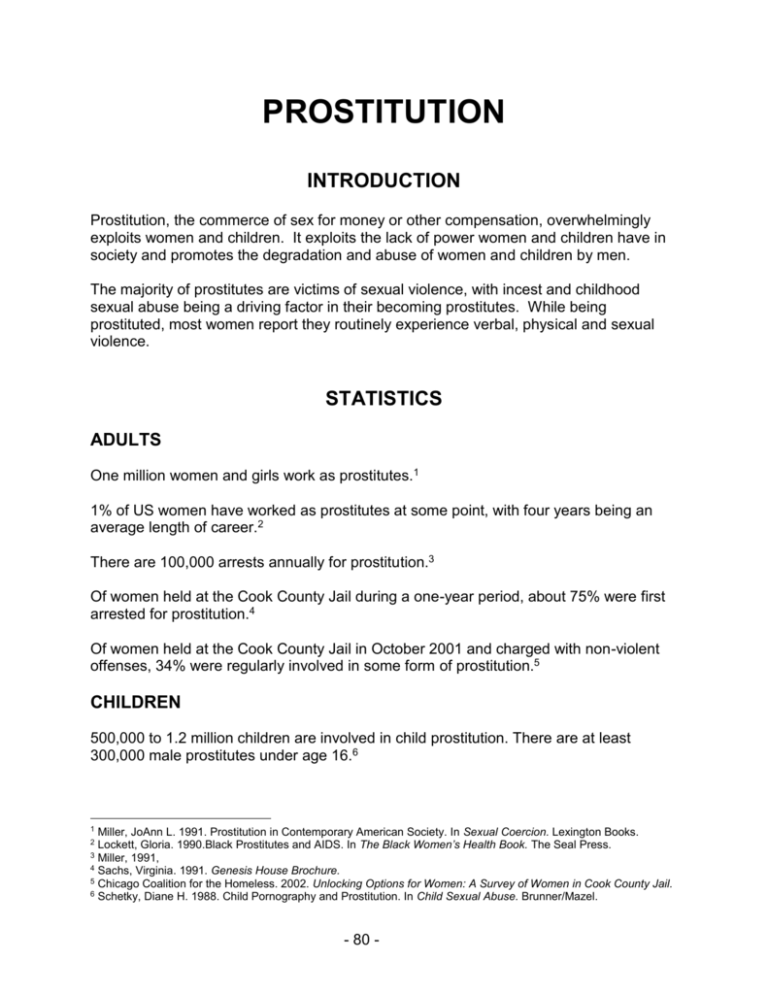
PROSTITUTION
INTRODUCTION
Prostitution, the commerce of sex for money or other compensation, overwhelmingly
exploits women and children. It exploits the lack of power women and children have in
society and promotes the degradation and abuse of women and children by men.
The majority of prostitutes are victims of sexual violence, with incest and childhood
sexual abuse being a driving factor in their becoming prostitutes. While being
prostituted, most women report they routinely experience verbal, physical and sexual
violence.
STATISTICS
ADULTS
One million women and girls work as prostitutes.1
1% of US women have worked as prostitutes at some point, with four years being an
average length of career.2
There are 100,000 arrests annually for prostitution.3
Of women held at the Cook County Jail during a one-year period, about 75% were first
arrested for prostitution.4
Of women held at the Cook County Jail in October 2001 and charged with non-violent
offenses, 34% were regularly involved in some form of prostitution.5
CHILDREN
500,000 to 1.2 million children are involved in child prostitution. There are at least
300,000 male prostitutes under age 16.6
1
Miller, JoAnn L. 1991. Prostitution in Contemporary American Society. In Sexual Coercion. Lexington Books.
Lockett, Gloria. 1990.Black Prostitutes and AIDS. In The Black Women’s Health Book. The Seal Press.
3 Miller, 1991,
4 Sachs, Virginia. 1991. Genesis House Brochure.
5 Chicago Coalition for the Homeless. 2002. Unlocking Options for Women: A Survey of Women in Cook County Jail.
6 Schetky, Diane H. 1988. Child Pornography and Prostitution. In Child Sexual Abuse. Brunner/Mazel.
2
- 80 -
Between 300,000 and 400,000 American children and youth are victimized by sexual
exploitation each year.7
In one study, 1/3 of the women entered prostitution before the age of 15, and 62% of
the sample were in prostitution before their 18th birthdays.8
Most children enter prostitution at the age of 14.9
60% of child prostitutes are first recruited by peers.10
96% of prostitutes who entered prostitution as juveniles were runaways. Most stated
they had no other option for making money.11
ECONOMICS
Approximately 14% of the gross domestic product of Thailand (U.S. $27 billion per year)
was supplied by sex businesses.12
In the Netherlands, prostitution is a $1 billion per year industry.13
MALES
27% of juvenile male prostitutes are involved in the pornography industry. 14
Male prostitutes are much less likely to be arrested for prostitution than females.15
RACE
40% of street prostitutes are women of color; 55% of those arrested are women of color;
85% of prostitutes sentenced to jail time are women of color.16
7
University of Pennsylvania. 2001. The Commercial Sexual Exploitation of Children In the U.S., Canada and Mexico.
Raphael, Jody, and Deborah L. Shapiro. 2002. Sisters Speak Out: The Lives and Needs of Prostituted Women in
Chicago, Center for Impact Research.
9 Schetky, Diane H. 1988. Child Pornography and Prostitution. In Child Sexual Abuse. Brunner/Mazel.
10 Ibid.
11 Silbert, Mimi H. 1984. Treatment of Prostitute Victims of Sexual Assault. Victims of Sexual Aggression. Van
Nostrand Reinhold.
12 Farley, Melissa, and Howard Barkan. Prostitution, Violence Against Women, and Posttraumatic Stress Disorder.
27(3) Women & Health (1988): 37-49.
13Hughes, Donna M. Illinois Coalition Against Sexual Assault. Demand: The Driving Force of Sex Trafficking.
Coalition Commentary (Spring 2003).
14 Schetky, 1988.
15 Ibid.
16 Brock, Nakashima, and Susan Thistlethwaite. 1996. Casting Stones: Prostitution and Liberation in Asia and the
United States. Minneapolis, MN: Fortress Press.
8
- 81 -
FAMILY BACKGROUNDS
25% of respondents grew up without a mother in the household and 59% without a
father.17
More than 60% of respondents reported domestic violence in the household.18
2/3 of prostitutes in one study were from families of average or high income, though as
adults they lived in poverty.19
76% of prostitutes in one study came from families that regularly attended church.20
More than half of prostitutes in one study said one or both parents drank to excess;
more than half had family members who abused drugs regularly. 21
51% of prostitutes in one study had a father who battered their mother. 62% of
prostitutes were physically abused as children.22
19% of prostitutes believed they had a positive relationship with their fathers. Less than
1/3 believed they had good relationships with their mothers.23
CHILD SEXUAL ABUSE
Most prostitutes have been sexually abused as children. Finkelhor and Browne state
that child sexual abuse leads to feelings by the victim of betrayal, powerlessness,
stigmatization, and the sense that sex is a commodity. These feelings often make
children vulnerable to revictimization, including child prostitution.24
2/3 of prostitutes were sexually abused from the ages of 3-16. (The average age of
victimization was 10).25
2/3 of prostitutes abused in childhood were molested by natural, step-, or foster fathers.
10% were sexually abused by strangers.26
17
Raphael, Jody, and Deborah L. Shapiro. 2002. Sisters Speak Out: The Lives and Needs of Prostituted Women in
Chicago, Center for Impact Research.
18 Ibid.
19 Silbert, Mimi H. 1984. Treatment of Prostitute Victims of Sexual Assault. Victims of Sexual Aggression. Van
Nostrand Reinhold.
20 Ibid.
21 Ibid.
22 Ibid.
23 Ibid.
24 Finkelhor, David, and Angela Browne. The Traumatic Impact of Child Sexual Abuse. 55(4) American Journal of
Orthopsychiatry.
25 Silbert, 1984.
26 Ibid.
- 82 -
70% of prostitutes believed that being sexually abused as children influenced their
decisions to become prostitutes.27
91% of prostitutes sexually abused as children told no one. Only 1% received
counseling for the effects of the abuse.28
In a study of prostitutes at Cook County Jail, 53% of prostitutes had experienced child
sexual abuse.29
EFFECTS OF CHILD ABUSE
Children who are sexually abused are 27.7 times more likely than non-victims to be
arrested for prostitution as adults.30
Men and women who were raped or forced into sexual activity as children or
adolescents were four times more likely to work in prostitution compared with nonvictims.31
57% of prostitutes reported having been sexually assaulted as children; 49% reported
having been physically assaulted as children.32
IMPACT ON THE VICTIM
HEALTH EFFECTS
Venereal disease and suicide attempts are the two greatest health risks for juvenile
prostitutes.33
Over 90% of women in both street and off-street activities increased their drug or
alcohol usage during prostitution.34
About half of the women reported having sexually transmitted infections.35
27
Silbert, Mimi H. 1984. Treatment of Prostitute Victims of Sexual Assault. Victims of Sexual Aggression. Van
Nostrand Reinhold.
28 Ibid.
29 Chicago Coalition for the Homeless. 2002. Unlocking Options for Women: A Survey of Women in Cook County Jail.
30 Widom, C. 1995. Victims of Childhood Sexual Abuse: Later Criminal Consequences. U.S. Department of Justice.
National Institute of Justice. Washington, D.C.
31 Population Reports: Ending Violence Against Women, 2000.
32 Farley, Melissa, and Howard Barkan. Prostitution, Violence Against Women, and Posttraumatic Stress Disorder.
27(3) Women & Health (1988): 37-49.
33 Schetky, Diane H. 1988. Child Pornography and Prostitution. In Child Sexual Abuse. Brunner/Mazel.
34 Raphael, Jody, and Deborah L. Shapiro. 2002. Sisters Speak Out: The Lives and Needs of Prostituted Women in
Chicago, Center for Impact Research.
35 Ibid.
- 83 -
15% of all suicide victims are prostitutes.36
75% of prostitutes have attempted suicide.37
PSYCHOLOGICAL EFFECTS
Because many prostitutes have been sexually assaulted, they suffer from psychological
effects of rape and child sexual abuse. These include rape trauma syndrome, low selfesteem, guilt, and self-destructiveness.
Prostitutes often will not seek counseling for their problems because they are suspicious
of outsiders and authorities, fear rejection, and fear change. Prostitutes often fear
admitting they have been harmed. They may have difficulty establishing enough control
over their own lives to seek counseling, and they may fear that health care and other
services will not help them because they are prostitutes.
Mimi Silbert, a counselor, states that many prostitutes have a “psychological paralysis”
that involves wanting help, but rejecting it. However, it has been found that if 24-hour
hotlines, counseling, advocacy and shelter care are made specifically available to
prostitutes, these services will be used. Counseling has been found to help prostitutes
recover from sexual trauma and improve their self-esteem.38
SEXUAL AND PHYSICAL VIOLENCE
79% of women in prostitution gave an indication that they were in prostitution due to
some degree of force.39
Women who reported being regularly involved in prostitution were more than twice as
likely to be victims of sexual assault or assault with a weapon by someone other than a
partner as were women not involved in prostitution. 74% said they had been sexually
assaulted as adults by someone other than a partner.40
Adults working in prostitution reported the following: 41
82% had been physically assaulted;
83% had been threatened with a weapon;
68% had been raped while working as a prostitute;
84% experienced current or past homelessness.
36
Raphael, Jody, and Deborah L. Shapiro. 2002. Sisters Speak Out: The Lives and Needs of Prostituted Women in
Chicago, Center for Impact Research.
37 Ibid.
38 Silbert, Mimi H. 1984. Treatment of Prostitute Victims of Sexual Assault. Victims of Sexual Aggression. Van
Nostrand Reinhold.
39 Hughes, Donna M. Illinois Coalition Against Sexual Assault. Demand: The Driving Force of Sex Trafficking.
Coalition Commentary (Spring 2003).
40 Chicago Coalition for the Homeless. 2002. Unlocking Options for Women: A Survey of Women in Cook County Jail.
41 Ibid.
- 84 -
Another study of adult prostitutes found the following: 42
73% had been raped – 71% since entering prostitution;
In 84% of rapes, the rapist was a stranger to the victim;
In 27% of rape cases, there were multiple assailants. The average number of
assailants was four;
44% of rapes involved the use of a weapon.
In a study involving prostitutes in nine countries, it was found that 71% of women in
prostitution had been physically assaulted in prostitution and 63% had been raped in
prostitution. 75% of the Canadian women in this study reported physical injuries from
prostitution: stabbings, beatings, concussions, and broken bones. Half of these women
had head injuries from violent assaults with baseball bats, crowbars, and having their
heads slammed against car dashboards. They were regularly subjected to violence if
they refused to perform a specific sex act.43
73% of prostitutes reported being sexually assaulted as adults in situations unrelated to
prostitution. Most of these were violent stranger rapes insulting in injuries.44
70% of prostitutes were victims of sexual assaults by customers.45
Only 7% of sexually assaulted prostitutes sought counseling, and only 7% reported the
crime to police.46
2/3 of prostitutes reported being physically assaulted by customers and 2/3 reported
being beaten by pimps.47
50% of prostitutes reported being kidnapped by pimps; 76% were beaten by pimps; and
79% were beaten by customers.48
42
Silbert, Mimi H. 1988. Compounding Factors in the Rape of Street Prostitutes, cited in Rape and Sexual Assault,
Vol. II. , A.W. Burgess, ed. New York: Garland Publishing Co., p. 77.
43 Sin Fronteras: Without Borders (Sept. 2003).
44 Ibid.
45 Ibid.
46 Ibid.
47 Ibid.
48 Giobbe, Evelina. Statement of WHISPER Action Group Members. 6(1-2) WHISPER.
- 85 -
RESPONSE
NATIONAL LAWS
Prostitution is considered a consensual offense – an illegal act in which both
participants willingly participate. Laws vary considerably from state-to-state; for
instance, Nevada prohibits prostitution only in counties with a population of more than
200,000, while Alabama considers prostitution to be a first- or second-degree felony.49
The FBI defines prostitution as: “To unlawfully engage in or promote sexual activities for
profit.” Customers are not included in FBI statistics for prostitution arrests.
Prostitutes are more often sentenced, and receive more severe sentences, than
customers.50
ILLINIOS LAW
In Illinois, prostitution is a Class A misdemeanor for both the prostitute and the
customer. A third or subsequent violation is a Class 4 felony. Soliciting a juvenile is a
Class 1 felony.
LEGALIZATION
There is considerable debate among prostitutes and former prostitutes about whether
prostitution should be legalized. Some groups believe that prostitution is sexual assault
and should remain illegal, with stronger enforcement of laws against solicitation. Other
groups believe that violence against prostitutes would decrease if prostitution were
legalized, making it a legitimate form of commerce. This, they argue, would decrease
the stigma against prostitution.
Genesis House, a Chicago organization that assists former prostitutes, summarizes the
debate as follows: “Where prostitution is illegal, the arrest and incarceration of the
prostitute merely confirm her low self-worth and expectations of abuse ... legalizing
prostitution does not help the prostitute, in that it confirms her idea that this is all she
can do or be worth.”51
49
50
Miller, JoAnn L. 1991. Prostitution in Contemporary American Society. In Sexual Coercion. Lexington Books.
Miller, JoAnn L. 1991. Prostitution in Contemporary American Society. In Sexual Coercion. Lexington Books.
51
Sachs, Virginia. 1991. Genesis House Brochure.
- 86 -
SPECIAL ISSUES
PORNOGRAPHY
38% of prostitutes stated that pimps regularly exposed them to pornography. 80%
stated that customers used pornography and photographs to demonstrate which
activities they wanted the prostitutes to perform.52
TRAFFICKING
Sex trafficking produces an estimated $7 billion annually.53
A U.S. Government estimate indicates that approximately 800,000 to 900,000 people
annually are trafficked across international borders worldwide and between 18,000 and
20,000 of those victims are trafficked into the United States.54
52
Ibid.
U.S. Department of Health and Human Services. 2005. Sex Trafficking Fact Sheet.
54 U.S. State Department. Trafficking in Persons Report (June 2003).
53
- 87 -


